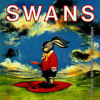Swans, "White Light from the Mouth of Infinity"
 In 1991 three exceptionally creative and influential records were dropped on a mostly deaf audience. It took many years for people to catch up with Talk Talk's Laughing Stock and Slint's Spiderland, and by then numerous other bands had already borrowed their ideas and built new ones upon them. Unfortunately, Swans' White Light from the Mouth of Infinity is still waiting for people to catch up. It completes the trajectory that was begun with Children of God and it perfects the ideas that were only half-realized on The Burning World. More than an influential record, it is arguably Swans' finest and most concise accomplishment to date.
In 1991 three exceptionally creative and influential records were dropped on a mostly deaf audience. It took many years for people to catch up with Talk Talk's Laughing Stock and Slint's Spiderland, and by then numerous other bands had already borrowed their ideas and built new ones upon them. Unfortunately, Swans' White Light from the Mouth of Infinity is still waiting for people to catch up. It completes the trajectory that was begun with Children of God and it perfects the ideas that were only half-realized on The Burning World. More than an influential record, it is arguably Swans' finest and most concise accomplishment to date.
Swans changed dramatically in the time between Children of God and White Light. Drummer Ted Parsons and bassist Algis Kyzis, one of the best rhythm sections in rock music, were absent by 1989 and sorely missed. The Burning World had demonstrated that Michael Gira and Jarboe were interested in taking Swans somewhere else musically, but poor production choices and too few sympathetic musicians prevented them from realizing their vision fully. It must have been tempting then for Michael and Jarboe to call on old friends for their next album, but instead they moved forward and assembled a large cast of mostly new collaborators. Parsons and Kyzis were still gone, replaced by Jenny Wade on bass, Dots percussionist Vincent Signorelli, and drummer Anton Fier, who founded The Golden Palominos and had played with everyone from The Feelies to Pere Ubu. Norman Westberg was still on board, but two other guitarists had been added to the ensemble: Christoph Hahn and Clinton Steele. Much of what I've read about White Light suggests that they were the primary guitarists in the studio, and both are credited in the liner notes before Norman is. Nicky Skopelitis (also a member of The Golden Palominos) was the only musician other than Westberg to survive The Burning World sessions, but it's difficult to assess how large a role he played given the diverse number of instruments for which he is credited. This is the group that, along with a few others, went into the studio and turned out Swans' most cohesive and complete statement.
But White Light isn't the evolutionary step forward that Children of God or The Burning World was. Gira and Jarboe had already moved past the stentorian assault of earlier records, both as Swans and as World of Skin. They had also covered Joy Division's "Love Will Tear Us Apart" and Blind Faith's "Can't Find My Way Home," proving that they were as comfortable with popular song styles as they were with their post-punk and No Wave influences. As Creaig Dunton pointed out in his review of The Burning World, Swans had composed some fantastic songs since turning their sound down ("God Damn the Sun" and "Mona Lisa, Mother Earth" especially). The band had already begun a slow and clumsy metamorphosis, but they had yet to complete it. All they needed to do was find the right lens through which they could focus their energies and things were sure to take off. That's where White Light comes in: it marries the band's more spacious and subdued efforts with the intensity and drama for which they had become notorious. On White Light their quiet ballads swarm with inviting melodies and brooding, often sad atmospheres. The aggressive songs exhibit restraint and overwhelming power without taking recourse to overt brutality. Gira and company had integrated all the loose threads from past works and synthesized them into an epic, frequently orchestral aesthetic that could handle any material tossed at it.
Their transformation into such a flexible and dynamic unit is evidenced by how clearly past songs are reflected in White Light. Even if it isn't an evolutionary recording, it is a transformative one that bears all kinds of new fruit. I mean transformative literally, too. Many of the songs on White Light sound like twisted reflections of songs from The Burning World. For instance, the meek "I Remember Who You Are" sounds like it could have been the form from which the stunning "Songs for Dead Time" was sculpted. And the intriguing, but ultimately flat "(She's a) Universal Emptiness" might have been the soil from which the majestic "You Know Nothing" grew. That latter song is especially superb, replete as it is with Jarboe's spectral harmonies, Gira's paradoxically romantic and frightening condescension, and its superb chorus. But if calling the record transformative sounds exaggerative, consider the album's opening moments, where a small child is heard cooing and crying before "Better Than You" begins, perhaps suggesting birth and birthing pains. Or think on the many lyrics and images throughout the record that suggest failing, dying, and becoming something new. One of the most striking is "Song for the Sun," where Michael, in an almost elated tone (and in blinding contrast to "God Damn the Sun"), sings, "But I won't cry, no / I will survive the light of the sun as it enters me / Let it come right in, let the sun come in." Musically and lyrically, Swans are concerned with change and transformation throughout White Light. Deryk Thomas' artwork adds weight to that interpretation, too, suggesting rebirth by way of spring, love, and possibly Easter. And if that isn't convincing enough, then read over the lyrics to "The Most Unfortunate Lie," where Gira reflects, "The light shows my face in the mirror / and my hand as it reaches to touch / the evidence of pain and delusion / and a mind which was never clear enough." Things must have cleared up in the studio during the recording of this album and everyone present must have recognized it to some extent. At least a few of these songs had to be written or redrafted during the album's recording. Of course, it could be that White Light is where everything happily and haphazardly fell into place, the lyrics reflecting the band's regeneration only by chance.
All of this ignores how excellent White Light is on its own, though, without reference to anything from the past. Were it actually still in print, a newcomer could begin exploring Swans with this album and fall in love thanks to its many strong melodies, excellent arrangements, tremendous scope, and various moods. In fact, if Soundtracks for the Blind had never happened, White Light might have gone down as the band's most diverse and dynamic recording. Fans might argue it isn't as far-reaching and experimental as later Swans albums are, but it doesn't have as many loose ends either. White Light flows like a Bosch painting from start to finish, its unique instrumentation and surprising tangents forming a pleasing, if disturbing, whole. Songs like "Love Will Save You" and "Why Are We Alive?" show Gira's interest in American music growing and his ability as a songwriter developing, and "Failure" is nothing short of a classic. Michael frequently plays it at his solo shows and fans still whisper about it beforehand, wondering if they'll get the chance to hear it performed. Taken into consideration on their own, every song on White Light is an excellent example of Swans' several virtues.
And that is as good a reason as any to wonder why White Light ended up being butchered and spread across Various Failures and Forever Burned years later. While Swans would use White Light's various conventions as a starting point for exploring new territory on later albums, its songs do not sit comfortably next to the music from Love of Life, nor do they benefit from being interspersed among various B-sides and outtakes. Taking those songs out of their proper context and then splitting them up over three discs simply makes no sense. Gira hasn't reissued anything by Swans since 2003 and nothing he has reissued adequately represents this album's scope. That needs to change, if only to make White Light available again for listeners who would be all too happy to pay for it. As of right now, blogs and other illegal sites are the only places it is available. Rather than fund the next Swans album with a collection of acoustic demos, Young God could release a deluxe edition of White Light that contained all the demos, B-sides, and instrumental stuff on a second disc, where they belong.
Despite being out-of-print, White Light has become a massively influential record. Swans obviously left a mark on everyone from Low to Godspeed You! Black Emperor, Mogwai, and Explosions in the Sky. Arguments for their influence on many other bands could be made, too (Bark Psychosis and Sigur Rós among them). "Helpless Child" and "The Sound" might have solidified their contribution to post-rock more firmly, but the seeds for those experiments were planted on songs like "Why are We Alive?," "Will We Survive," and "Miracle of Love." For as long as I've been listening to Michael Gira's music and talking about it with others, Soundtracks for the Blind has been touted as their ultimate achievement and the place where all their experiments came to shine most brilliantly. But I think it's about time White Light from the Mouth of Infinity is recognized as their masterpiece. This is the album where Swans found new life and the mouth from which the rest of Gira's career flows, including Angels of Light.
samples:
 




